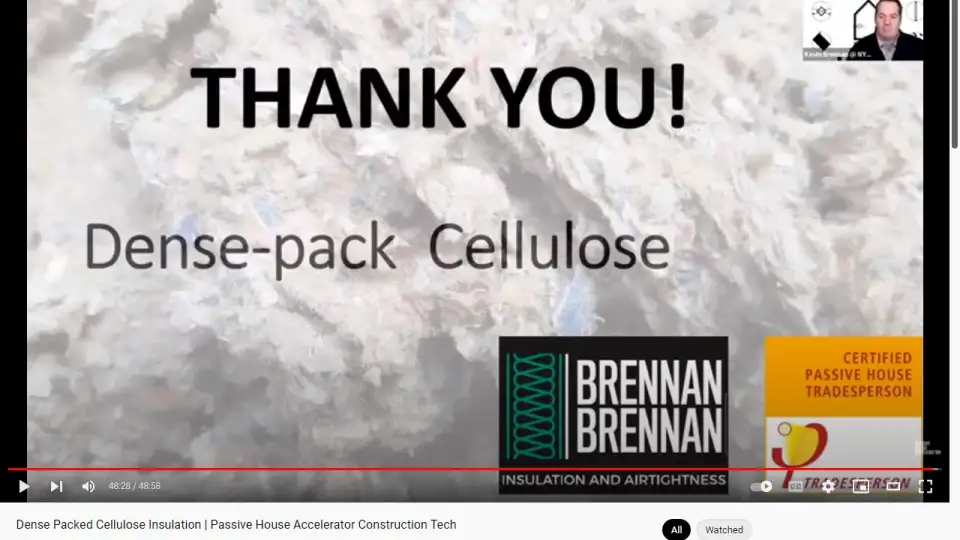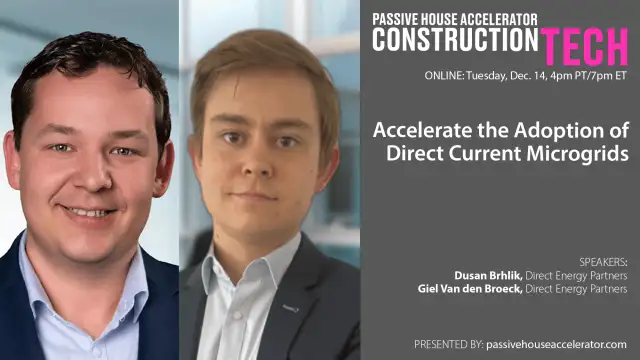In this video, Kevin Brennan, co-owner of Brennan & Brennan Insulation and Airtightness and Construction Tech co-host, provides a tutorial on and onsite demonstration of dense packing cellulose for superinsulated Passive House construction.
View the video above or read the transcript below:
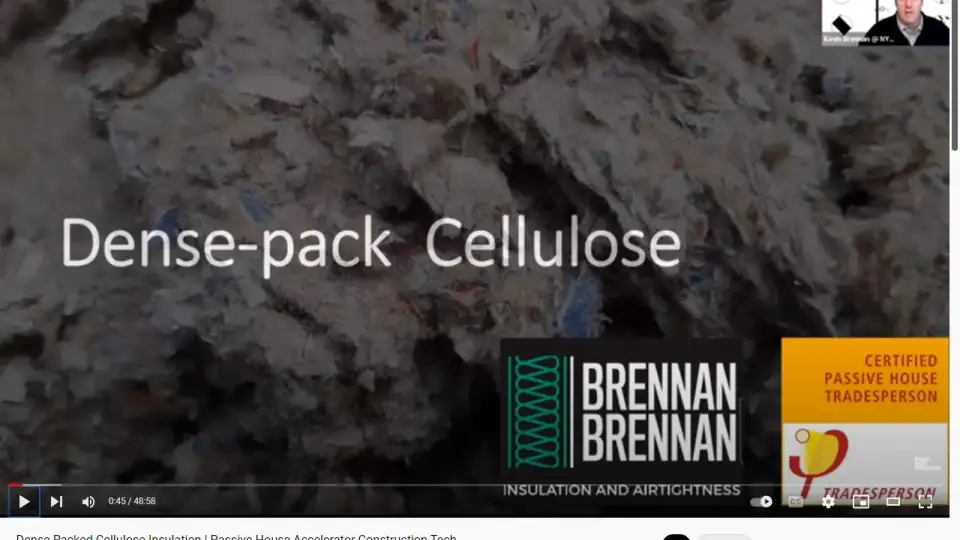
I'm Kevin Brennan from Brennan Brennan Insulation & Airtightness and who I am and what I am you guys will know, but one of the things I take great pride in is being a certified Passive House tradesperson. I look at being a Passive House tradesperson as the top of the pyramid of the skills needed in construction. And one of those basis of skills was taught to me very early on in my career and it's something I take great pride in, and innovating and trying to get to the top of my career chain is this is my history.
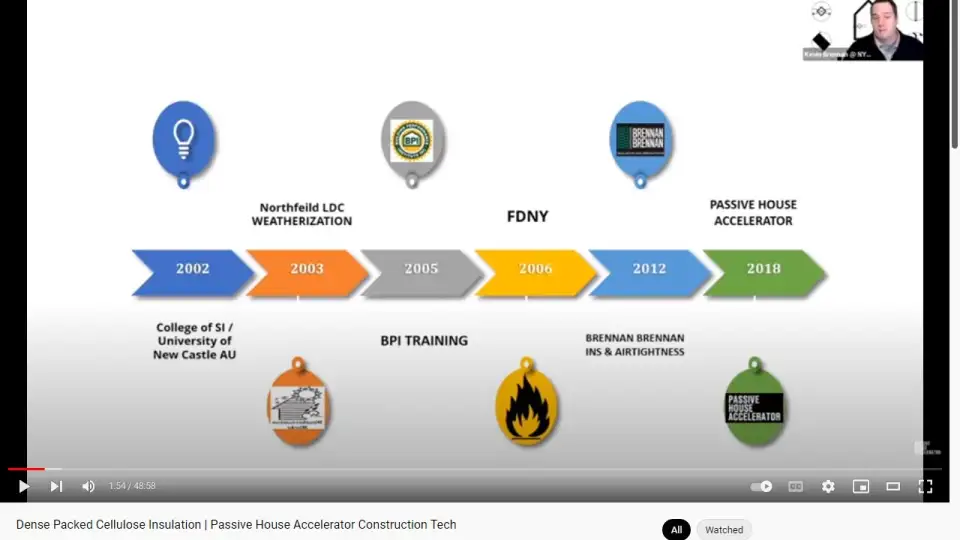
You guys can get some further insight on listening to the wonderful podcast that Zach put on for me and it was a great show. So in 2002 I was at the college of Staten Island and I wanted to get the hell out of here. So I figured out a way how to get a study abroad program to the University of New Castle in Australia. I loved the culture. I loved the place. I had great experience and when I was there I noticed that there was just of kind of a greater appreciation for the work and hands that were out there. And when I came back and I just took a step back I realized maybe I wanted to get into the trades. So at that time right after I came back and I had a decent amount of debt when I came back because I took one too many trips and had too much fun, I said, ah, college could hold off. I'm going to take a job and I found myself working for a weatherization agency. If anyone is not familiar with weatherization, it's a nonprofit kind of federally funded program throughout the U.S. that fixes people's buildings by using air sealing and insulation.
It's kind of was a driver of building science. The next step in that training program that I was involved in at Northfield through my jobs as being an air ceiling installer, to the post inspector, to the energy order it was taken to BPI training. BPI training was great, opened up the world of building science to me. Really got my curiosity going of how buildings are built, why they're built, what are the mistakes that they have, how do you solve those problems?
And speaking of solving problems, in 2006 I was the very lucky recipient of a phone call and results on a test that allow me to have the opportunity to serve the City of New York as a New York city fireman. So especially after these past few days at the deadly fire in the Bronx, you really appreciate that you get the opportunity to go out and help people on their worst day. I work in the Bronx and luckily my firehouse wasn't there, but if we were there we would've done our best to help those people at that time. But some of those problems in that building are kind of air sealing and insulation related.
Not to really nerd out on that, but the compartmentation of that building probably wasn't where it really where it needed to be. So I've been a fireman for since 2006. I've been involved in Passive House through working for the Association for Energy Affordability and other places being a trainer and teaching people about Passive House. And in that process of teaching people I had the opportunity to talk my way on to actual Passive House projects like Mike's and say, hey, we can do dense-pack cellulose. It's a core competency of ours.
And next thing I opened up a business with my brother Brennan Brennan Insulation & Airtightness and going since 2012. And I've had the great pleasure of being a part of this lovely team, the Passive House Accelerator in 2018, and this timeline is going to continue on. But while I was preparing for this lovely presentation I went back in time in Google photos and went through all my pictures of cellulose in the history that I have. So I'm going to share some of those early pictures that I have.

So this is a lovely picture of my good friend Pete Bento and my crew leader at Northfields. There was a weatherization department. That is the cellulose truck with the hose coming out the back, the generators on the street. I'm up in the attic blowing insulation for the loose field cellulose.
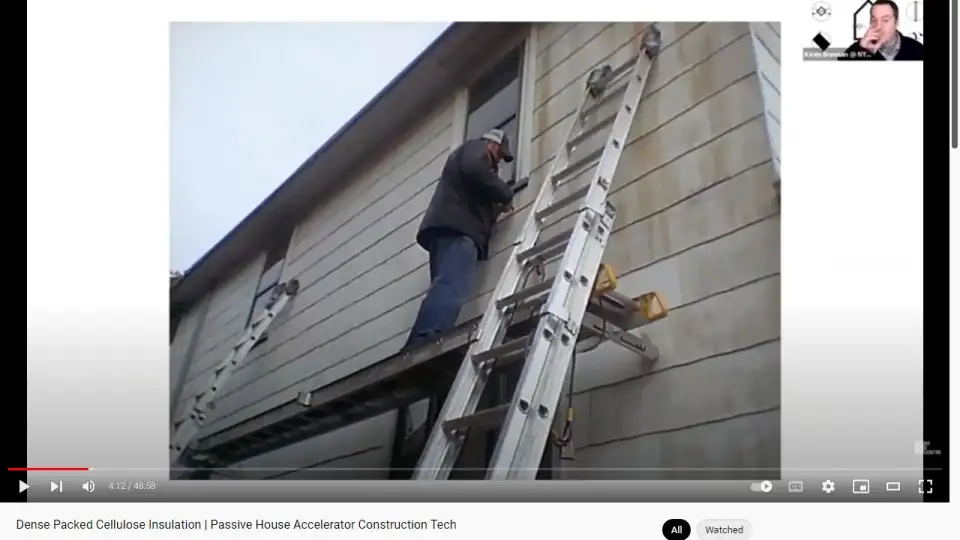
That's my brother, Gerard, who worked for the company as well. He's taking off siding on a cold day. That's asbestos siding, cement based siding and not an easy thing to take off, quite a technical skill, but that was the bread and butter of what we did for the weatherization agency. So our crew was kind of a New York City base, but we kind of worked on kind of suburban buildings in Staten Island. So we did a lot of dense-pack cellulose unlike what people think are the building typology of kind of New York City.
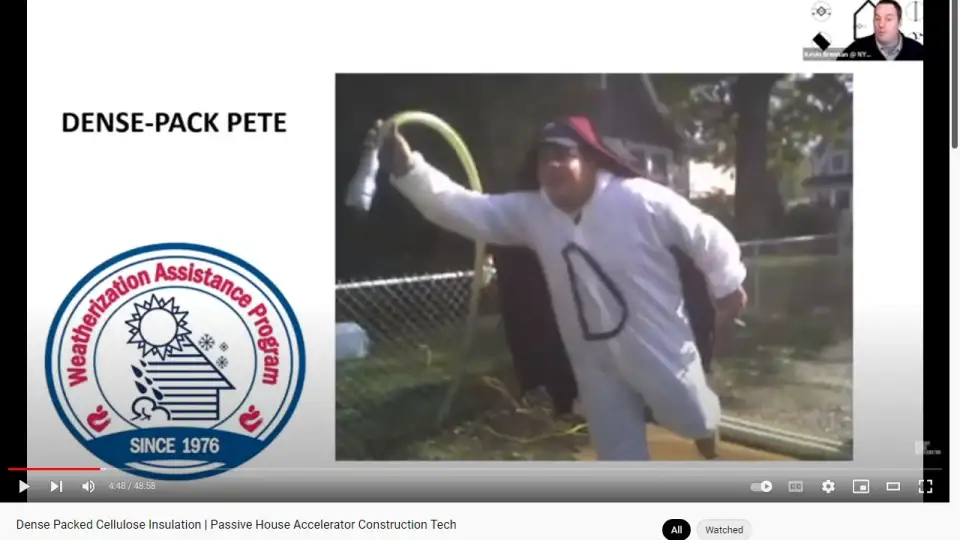
And that's my man dense-pack Pete, right? So we called him dense-pack Pete because that's what he took great pride in. That was actually a day where they were kicking him off the BPI program. Steve Thomas came to town, we were showing off all our skills and dense-pack Pete there. So we took great pride. Pete works in energy efficiency right now. I hope he's watching in the crowd or sees a video of this, but I send him this photo all the time. It's a great aspect of what it's like to work on a team and people that don't take themselves too seriously, but they take their job pretty serious that they call themselves dense-pack Pete.
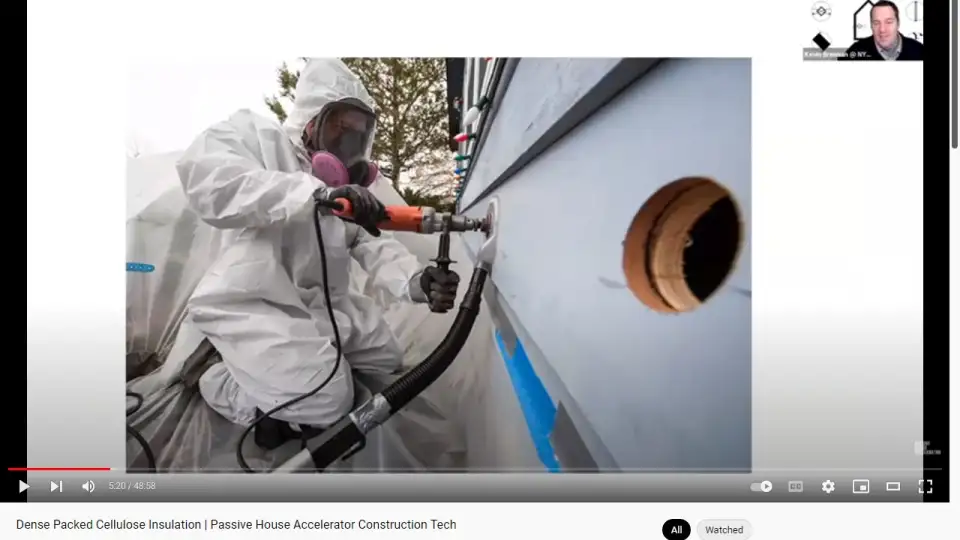
So the humility is out of the way and this is what the real job is. The real job is on the outside of a building, drilling holes on uninsulated buildings or under insulated buildings, accessing the empty cavities and filling them with cellulose insulation. Sometimes this process doing a pre-blower door and a post-blower door we would air seal the building between 30% and 50% if we did a really good job of seal up the building and doing attic air sealing. So it's a great opportunity of what we did.

So in 2006 I had the great opportunity to join the New York City Fire Department. I was assigned to ladder 80. This is one of our training photos and where my career kind of stopped in energy efficiency, I geared up my career in the fire department. As a fireman we work two 24-hour shifts a week and then we have three days off in between to work in the trades. And I've always wanted to work and keep my training going and build on my career in energy efficiency. So I was really looking to find my way.
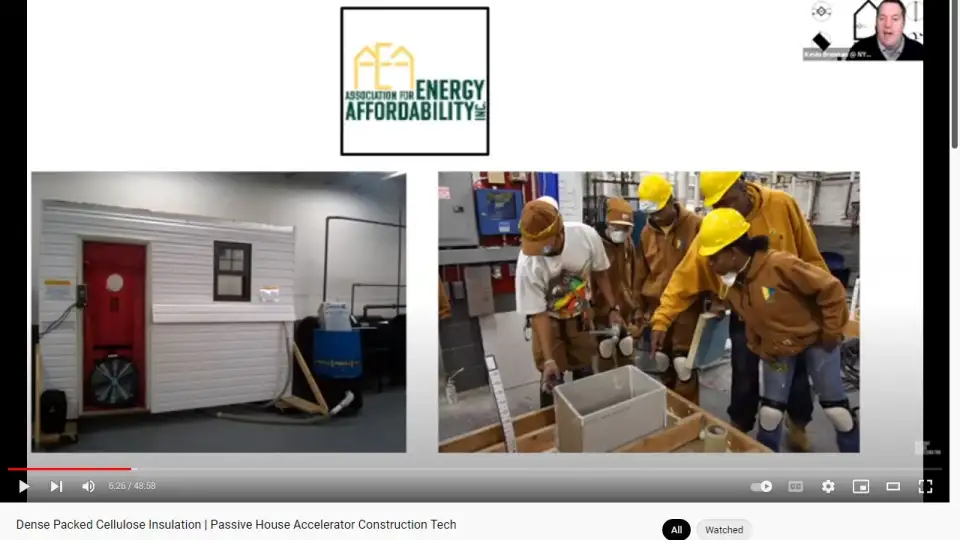
While I was trying to find my way I found my way back to where I took all my BPI training. This is the Association for Energy Affordability up in the Bronx. They had a lovely energy training center. And at the training center we did all sorts of trainings on energy efficiency and then when arrow hit and at that time we started doing workforce development training. So this is a group of students that come from the Sustainable South Bronx, Majora Carter's group. We did a bunch of training for them. That prop there showing them how to do some air sealing and we eventually got to do some dense-packs cellulose for them, kind of a workforce development program.

This is another one of our workforce development props. My job at the AEA was to be the air sealing installer trainer. So kind of the hands on trainer teaching workforce development and future weatherization employees and current weatherization employees how to do dense-pack cellulose well. And as much as I thought I knew, I didn't know. So the reality was I wasn't really well trained. I was trained on how to do my job. It was more touch and feel and tradition. It wasn't as science and technique as I learned by working in the props and digging down deep into the process of working there. So we drill the holes, we fill the tube in and then we dense-pack each one of them. You can see that each cavity is two by four cavity is fully insulated.
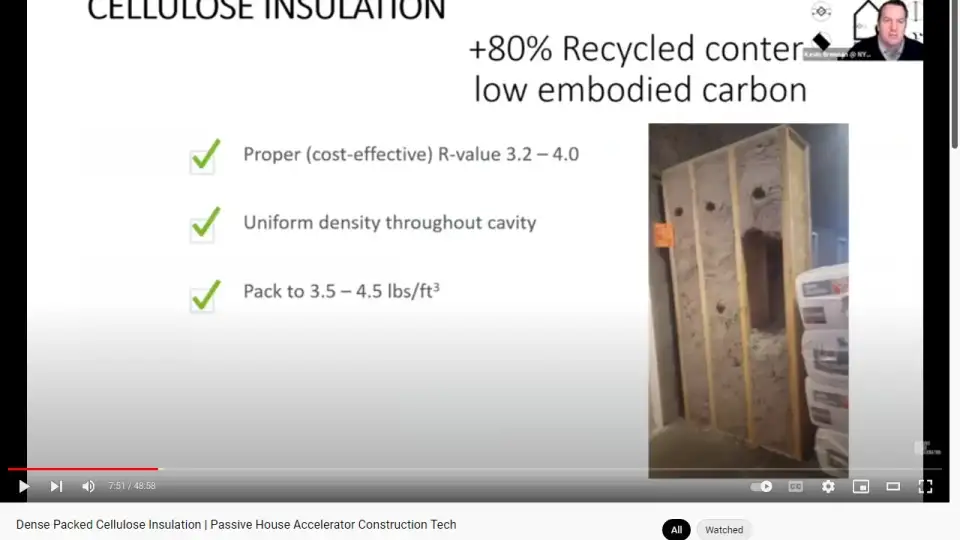
So what is cellulose insulation? Dense-pack cellulose insulation and why it's good is in my opinion it's above 80% recycled content. It is a very low embodied carbon insulation compared to say fiberglass, or Rockwool, or spray foam, some of the other options that are out there. The beauty of the product is that you're blowing it in and it's filling the whole cavity. So it doesn't care what shape or size it is whereas other batt forms need to come from the factory in the right size.
So proper R-value meaning the cavities fully filled with insulation, and the R-value goes from R 3.2-4.0. So one of the things I'll talk about in this presentation is finding the right manufacturer that gives you the right R-values to meet those levels. Uniform density throughout is the key component of the nozzle men or the nozzle team's integrity. So making sure that the nozzle goes into the right spot, fills the whole cavity and that you have some quality assurance or ways to check that you're at three and a half pounds to four and a half pounds per cubic foot.
And I'll show you ways to check that. There's many ways to do it and we'll go through that. The picture on the right you can see that the insulation has been hollowed out of that eye joist two by 12 wall and that's a Passive House level wall for anywhere throughout the world, maybe super insulated wall, but you can see how the insulation is self-supporting of itself. And that means that it won't settle over time and that the whole cavity is filled through pneumatic pressure. So here we have a little video of a tour I took of Igloo.
It's cellulose manufacturer up in Montreal and I'll play the video. I'll play the sound too. Why not? We'll get crazy. So those are the piles of cellulose. It's recycled paper distributed and put through, it goes through a machine. The piles right there are undistributed paper, that's the gold of good cellulose. It comes down to a certain mix and density. It gets put through the processing machine. That's the bagger, that's the borate or that could be magnesium. That's the fire retardant and the rotor propel of the material.
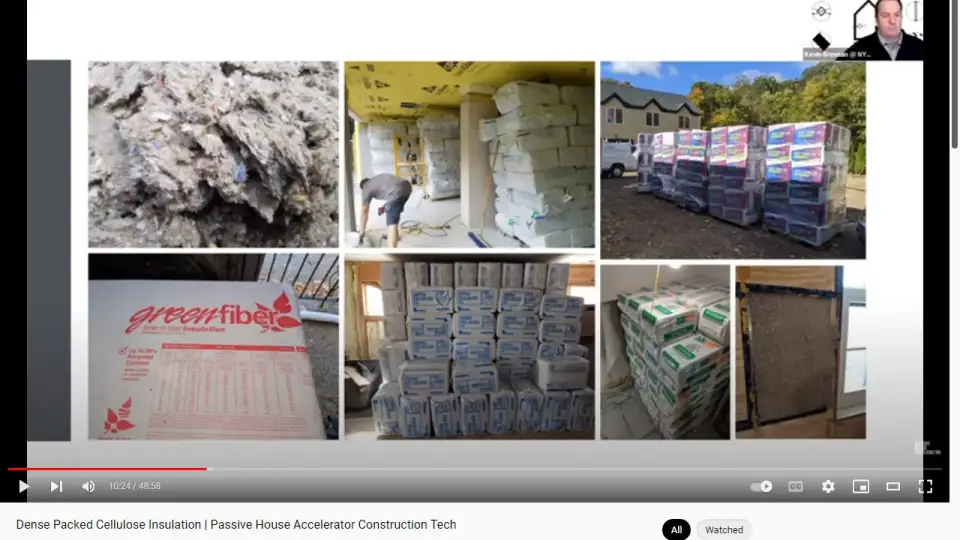
There's the bagger, that's the quality assurance machine weighs each bag. My buddy, Darren from Soprema and it's a fun experience to see how cellulose is made. So we have how cellulose is made, recycled content. It's a mix of distributed recycled paper and a better quality paper is undistributed paper, but it's all recycled content. It's not new paper. And then it goes through a treating process that grinds it down and softens it up. And then it's added into it is anywhere from 13% to 15% borate.
I personally prefer the ore borate, some of the other aluminum sulfates, magnesium sulfates. I don't like the corrosive nature of those products, not like borate is inherently, but it's a road repellant at a fire retardant. So in the picture here we have Greenfiber down at the lower left. We have Soprema down at the bottom that says AB, that's all borate. We have Igloos product in the green. We also have the new Greenfiber Sanctuary product on the upper right and then in the middle we have the Newell product. I think, believe it's out of the Midwest and that's a great product.
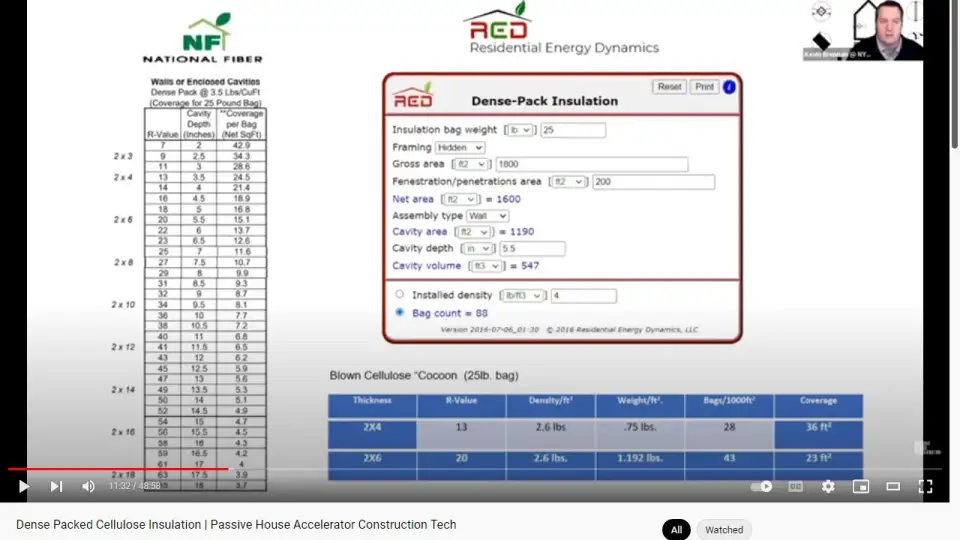
So those are all different brands that I was able to get to New York City and use on my projects. So now we have... How do you choose how much installation you really need? So if I was using fiberglass I'd go to the distributor and I'd say, I have two by six construction. I've got this 1200 square feet and they'd sell me how many bundles I need. With cellulose you got to do a little bit of math, right? So the simplest conversion is down at the bottom here where you have a two by four and you figure out, all right, I got two by four construction how many square feet?
And what's my coverage rate per bag? 36. That's great when you're dealing with two by fours and two by six in passive house. We don't deal with two by fours and two by six. We're dealing with odd shaped framing double studs, Larson trusses, eye joists. So it's not as cut and dry as we may think. That's why cellulose fits really well into the passive house world is that it fills the whole cavity no matter the shape and the geometry and you have to work out a way to get the nozzle in the right spot.
So the two tricks to the trade are the advanced coverage chart on the upper left here by national fiber. And then the residential energy dynamics calculator that I use most often that helps me to figure out how many bags of cellulose do I need and what density am I going for. The general rule thumb, as you increase in size of the cavity, meaning going from two by four, up to two by 10, you want to increase the density. And I think the maximum density is really recommended as four and a half a mile, but you really don't want to be below that.
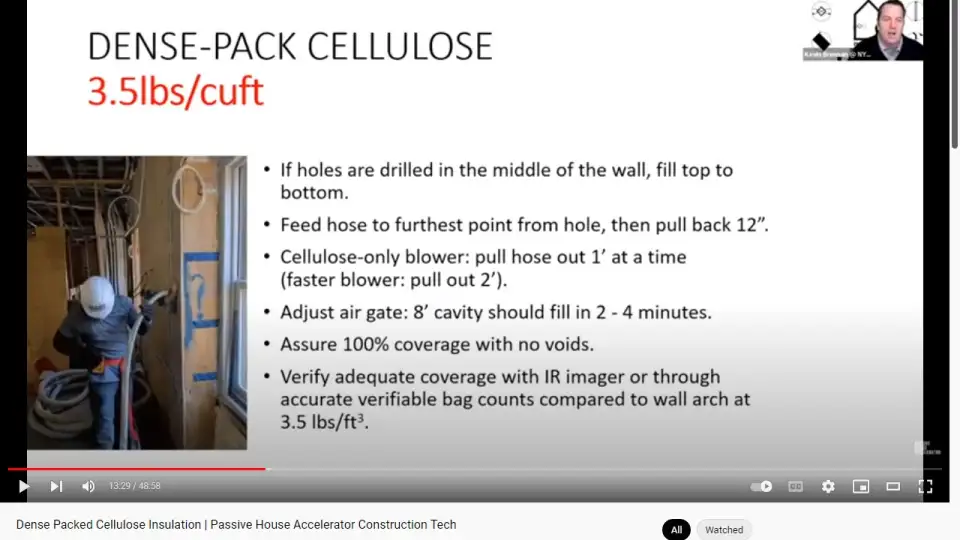
So you put it in there, you get your sweet spots, your contingencies add 10% for just to make sure you have enough material on site. And then these are all the tricks of the tools that I have. So we've got a member of my team, Mike Selufo there. He is putting the tube in the wall. So what type of wall is that? That's a wall and a brownstone. So the wall is furred off the wall by one inch, the framing is off. So it's about a four and a half to five and a half inch cavity depending on how it was framed, if was square, if it was level.
And our goal in dense-pack cellulose is to pack that cavity uniformly so that we get throughout that cavity three and a half pounds per cubic foot. So general rule thumb is you drill where it's comfortable, kind of right it shoulder height, you drill the hole, you feed the tube up to the top, you pull it back by 12 inches, you set the blower up and you blow out all the material in the hose. And then as you go along, I'll show you in the video, you go along and then you fill the whole cavity loose fill. And then once you start to slow down the machine, now you're dense packing at the tip tube.
And then you're slowly being pulled out of the hole by friction and pressure and going across. And then you're going to make sure that you have 100% coverage. So general thumb is if you don't get the tip of the nozzle there to where it is drill another hole and that's with there. You can use an infrared camera to make sure that it's there that you've accessed every single cavity especially when you're blowing behind say the plywood, which is tough to know if you've got the cavities, that's where it takes a little bit of nozzle man and backup man, backup integrity to drill the holes for you.
And then you also want to keep a bag count as you're going along. So if you've done seven base you want to know how many bags you've done streaming across. Talk about communications later, keeping the team in line of what's happening, what's going across there.
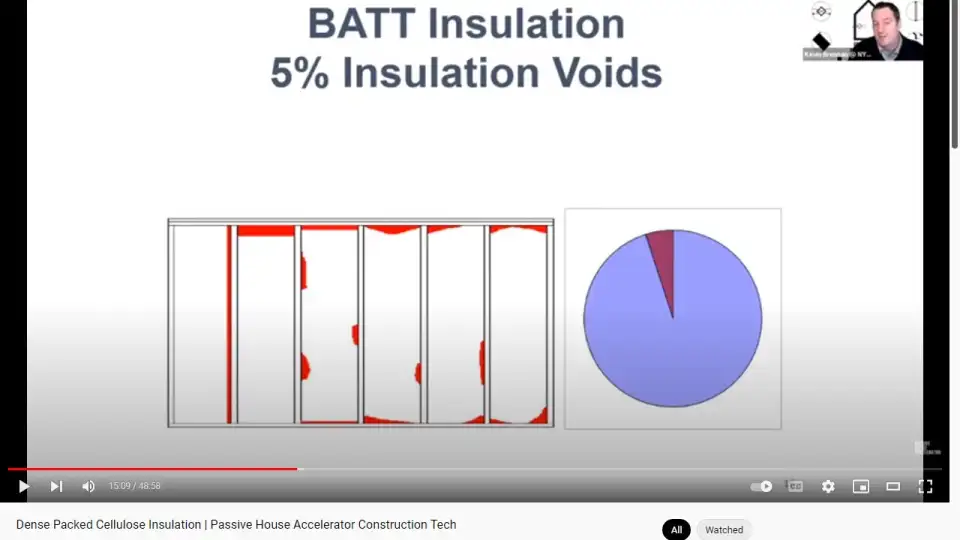
So why do we install cellulose as opposed to batts? I feel that batt insulation is kind of an unfair test. I wasn't really a great student as you can tell by my college career. But if I'd scored a 95% on a test I would expect that I did a pretty good job, that I didn't get too many errors, but to then go through and realize that I got a 40% on that test, it's not really fair.
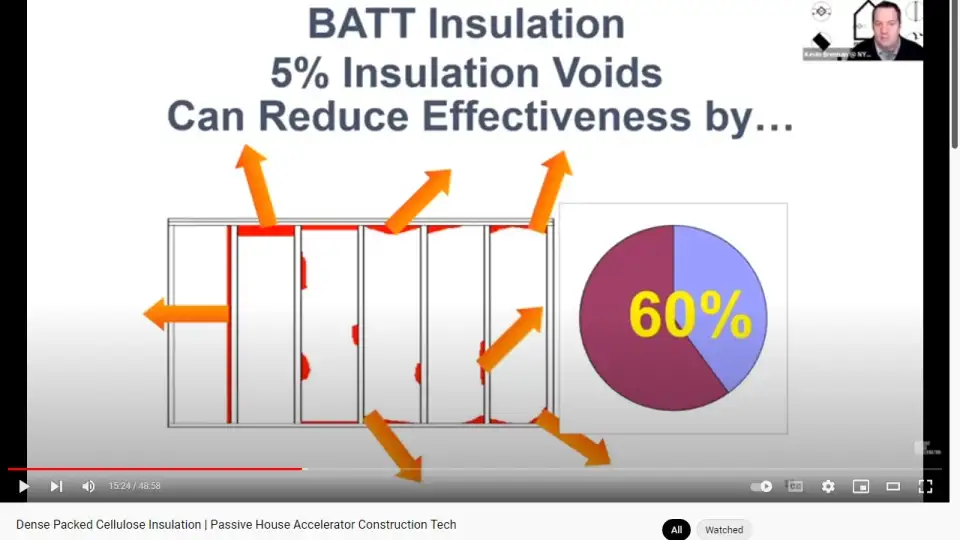
So what is it? Is it people, is it process or is it products? And sometimes it's all the above. So if I can do a process that helps me install it better and easier, I might want to go with those products that ensure that the people installing are set up for success. And that's why I like cellulose so that when I'm insulating a wall I'm using the pneumatic pressure of the machine to make sure that it's fully filled and I'm not getting little gaps and errors going across because I've never met a wall that's perfectly straight, or perfectly plum, or level. They always have a little tweaks. And when I get material from a factory that's set up, maybe that has some quality assurance issues too.
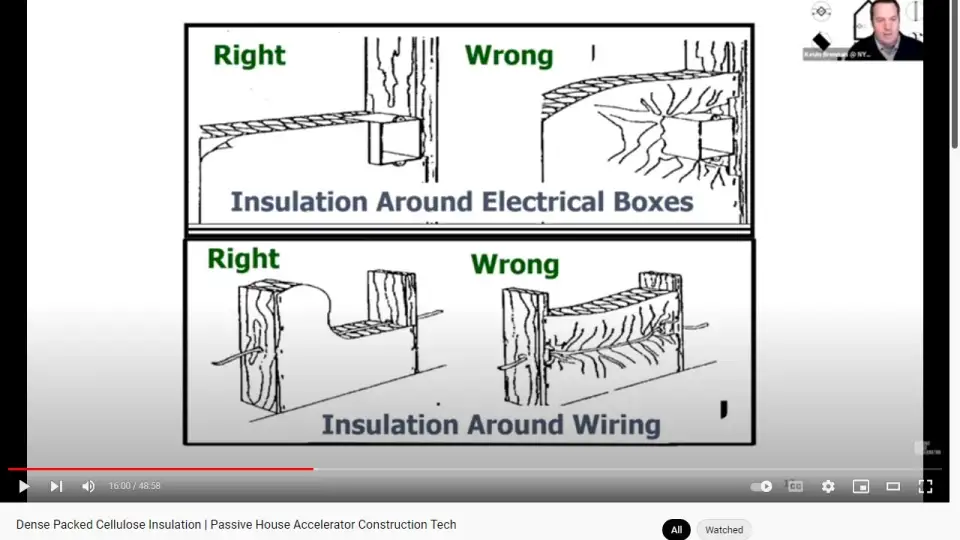
So when you have insulation around electric boxes, they need to be cut perfectly and stuffed in the back. When you have electrical wiring going through the insulation, you want to make sure that you split, you see cut it and you split it. It's not and possible it can be done. And we do it from time to time as a contractor, we install Rockwool and high density fiber glass batts from time to time, but the preferred method for us is to do the cellulose because we find it's a little easier. It takes a lot of time and effort to do it right.

So these are pictures of projects that I've worked on. That round staircase there is Rockwool being put into sound batts. And even though we took our time it's still not perfect. It still has gaps in compressions. I would say that that's probably around 5% errors. And then the one on the bottom, where the faced fiber glass R-13 is kind of squished in place and just stuffed, I would say that's closer to 10% to 20% errors. So the effect of R-value is going down even less.
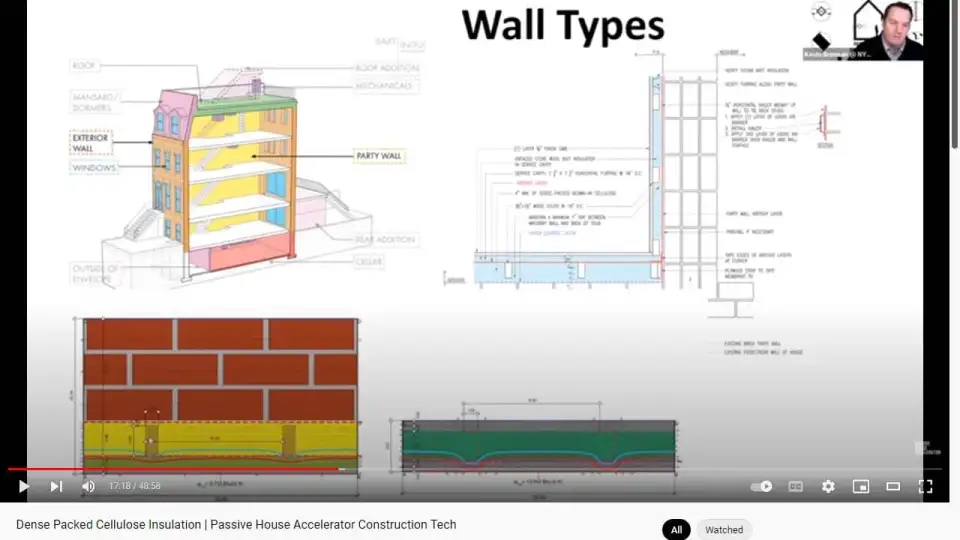
I am proud to see that they did insulate where I think a tub is going, but it's still not perfect. So what type of walls are we dealing with most of the time? So most of my work is done in brownstones on Passive House projects. So in the brownstones our front and back walls here are using a 2x4 stud that is furred off the wall by one inch. Then there's a membrane of some sort. It could be an air tightness membrane like Intello or Siga's membrane or even Partel's membrane, or it could be plywood. So some of the projects we work on the GC likes the plywood.
Some of the projects work on they like the membrane. So we do whatever the team really wants. And then we fill this cavity with insulation. So this will be a four and a half inch cavity fully filled with insulation. The hardest thing to get is the space between the studs if we weren't using cellulose. You could see a better corner drawing here of the cellulose and the studs and the drywall finish. So this would be from the outside. This would be the inside finish.
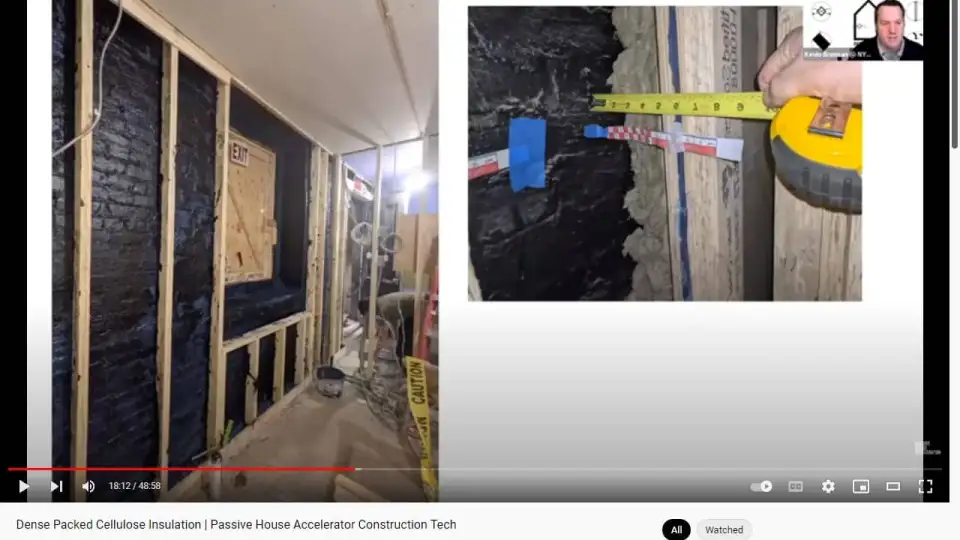
In this picture we show how the framing works and how the framing is in place. It's furred off the wall and here it's done by at least one inch. It's a little tight to the wall, to be honest with you there. Maybe it didn't get that full area. And this is a way that we are showing that near the door there we're almost at five inches of space behind the door because of framing issues and reasons. So those lovely little markers there are the PHI printable kind of installation depth checkers. We've been putting them in place just for the documentation process of Passive House. It lets us know that we took a picture and that we measure the installation that's there. All right.
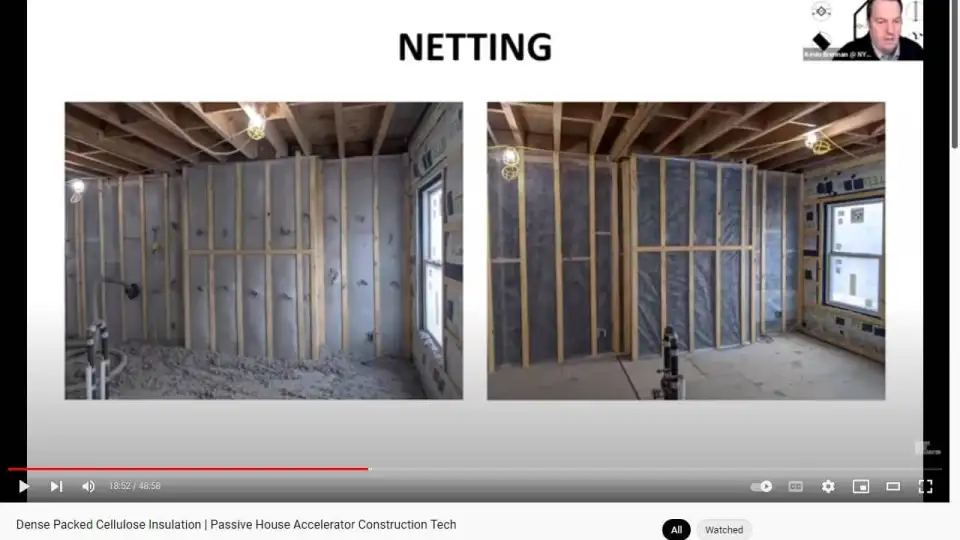
So we have walls and we have to blow insulation in them. Sometimes on our party walls where we have a fluid applied air barrier and they want insulation for soundproofing or maybe some gaps, but they don't need the air barrier that's there or the product is not going for certification but they want some extra soundproofing, we'll put up netting and then netting will act to keep our insulation at bay. The netting is different, but it just acts as a spring to keep it in. So you can see on the left where it's all blown in. Cellulose is a dirty job sometimes, but once it's in you can touch every area, you can know the density of it by touch and feel, and then making sure that that nozzle goes exactly where it needs to go.
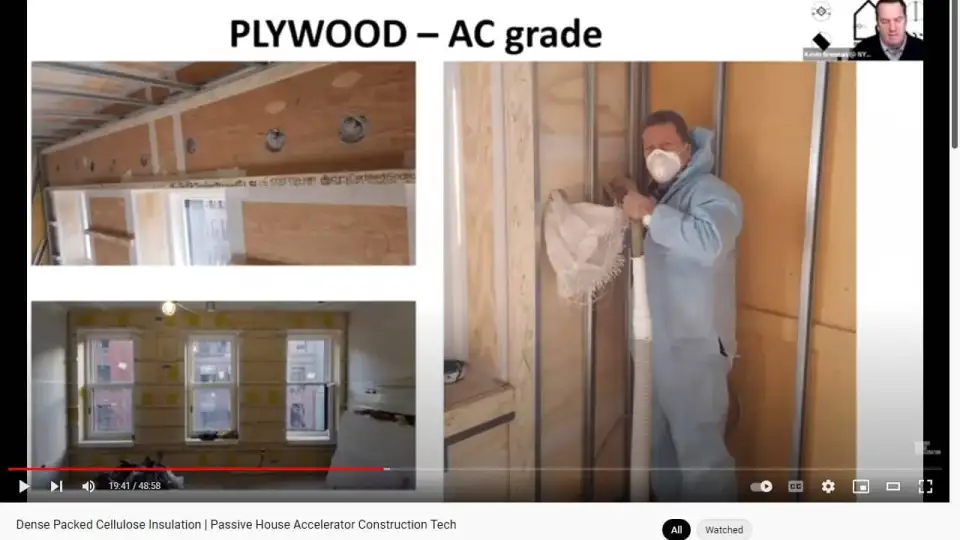
The next area, next projects that we work on is going behind plywood. So the plywood on some of our projects it just gives it that extra resilience of during construction. Once it's up it's not going to get damaged. If you go through it, it's you have to take saw or a whole saw to get through the plywood. Some of the general contractors we work on with the risk of the front and the back wall, they like the plywood. They like the rigidity of it. Their background is being carpenters. So they like to frame walls and put up the studs. That man on the right there is Louis from AEA. He is nozzle man kind of installation blow extraordinaire. He's wonderful with the nozzle. I had a great privilege of working with him for a few years and they did great work, him and Angela.

This is my team. We're showing the process of that. You have to drill the holes. That's Eva on my team. She's drilling the holes and then the holes are filled up there and we got Mike up there that's going across and dense-packing that slope, which is probably eight to 12 inches with the two and a half inch. That's a insulation needle. So these are all done with the smaller tube and we'll go through the process. All right.
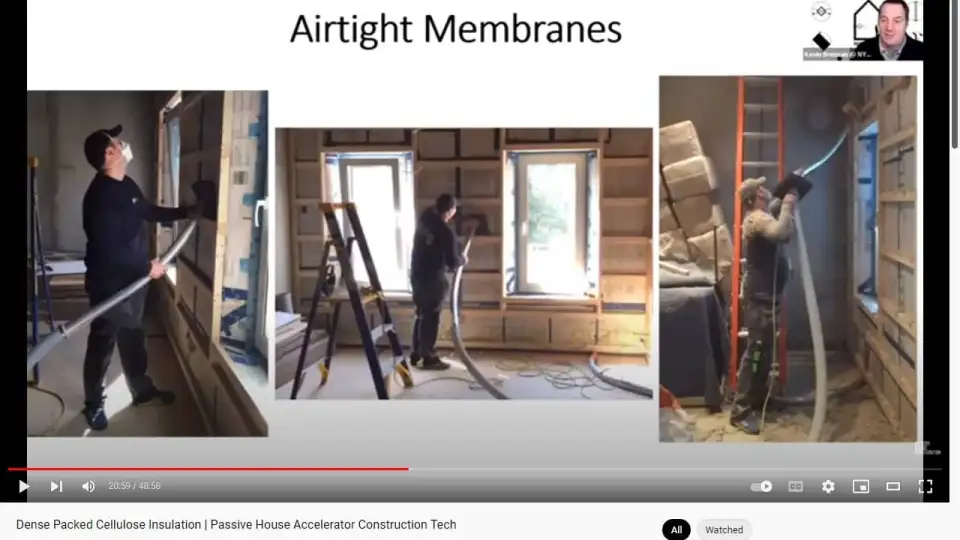
So the picture on the far left is how you start out doing cellulose nice and clean, no dust with a dust mask on, maybe no eye protection on because I'm never going to spray cellulose on myself. And then in the middle is the process of doing it. So there I'm using an insulation needle which is a German XFLOC needle and I'm weaving it up into the cavity. That cavity is five and a half inches, maybe six inches. And it's putting the insulation in between the membrane and getting it all the way up to the top there. And I'm using the hard tip of the nozzle to make sure that it's going in the upper corners. And I have a certain amount of feel of when it's coming down. And then the picture on the right is the reality of sometimes you do a dirty job and you get dirty and dusty. There's been some evolution in there that we use better safety protocols and Tyvek suits and different respirators just because of the nuisance of it.
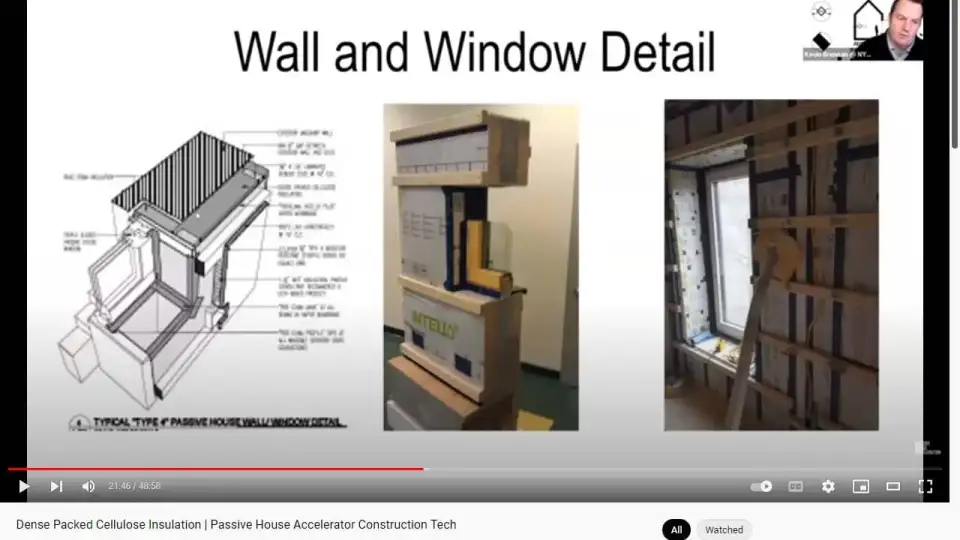
These are all wall types, just a little further explanation of them that they're two by fours furred thorough the walls, cellulose is in here, an air tightness membrane that's here and the three, four layers of white brick of installation there. This is a mockup of a double stud wall that we haven't had the luxury of actually doing inside New York City on any brownstones. But the wall that we're building, it's not fitted. It's not really a double stud wall, but it's not far off. We don't need that same full thickness of the double stud itself because of the attached building on both sides, which are wall types.
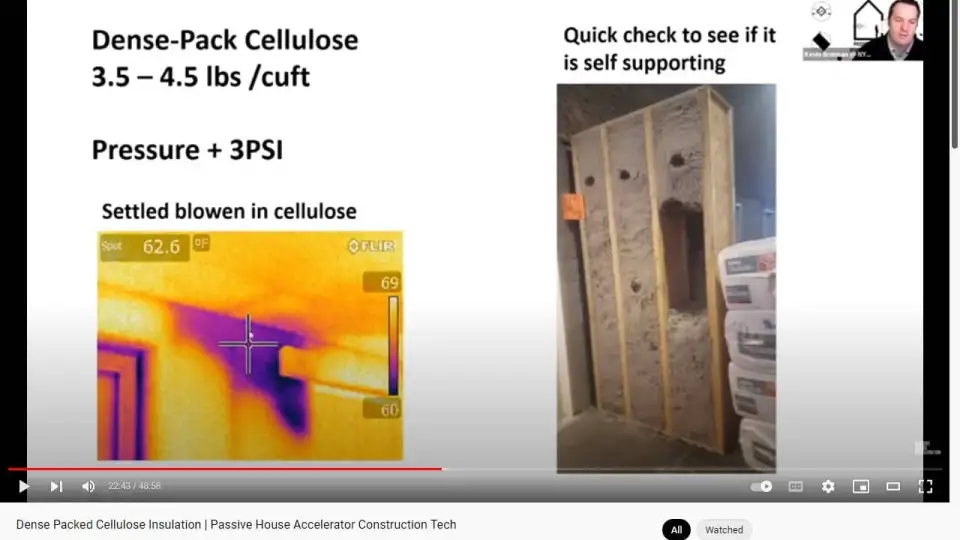
So nuts and bolts of dense-pack cellulose. You want to make sure that your density is at three and a half to four pounds per cubic foot. How do you keep track of that? It's bag count, it's a square footage coverage, but it's also a quality assurance method of touching and feeling when you have membranes opening up areas that taking a piece of plywood off and just checking to make sure that it's done properly. And then you can use the thermal imaging camera to find any gaps or missed areas.
Right here this was blown a few years ago and they showed that the insulation settled over time. If you have a good crew that has a good machine that's been loved and taken care of and has high pressure, the chances of the cellulose settling are few and far between. But if you're going out and renting a machine from Home Depot and doing it yourself, there's a very good chance that that could have because the rental machines are just meant for loose blow. They're not meant for high density dense-pack cellulose. And I'll show here again is this is a two by 12 eye joist that is filled with insulation and it's self-supporting.
This is the holy grail of knowing if you have dense-pack cellulose is that you open it up, you take out the middle and if it can support itself the weight of itself with 12 inches of it weighing on top of itself, that it can handle the pressure it won't settle over time. We do core samples as well which I'll get into later. So here we have our cellulose machines. This is where the rubber hits the road. So we have a few different manufacturers in the U.S. that we're very lucky to work with. Krendl, cool machines, Intech, and then there are a few other smaller distributors that I don't know the names.
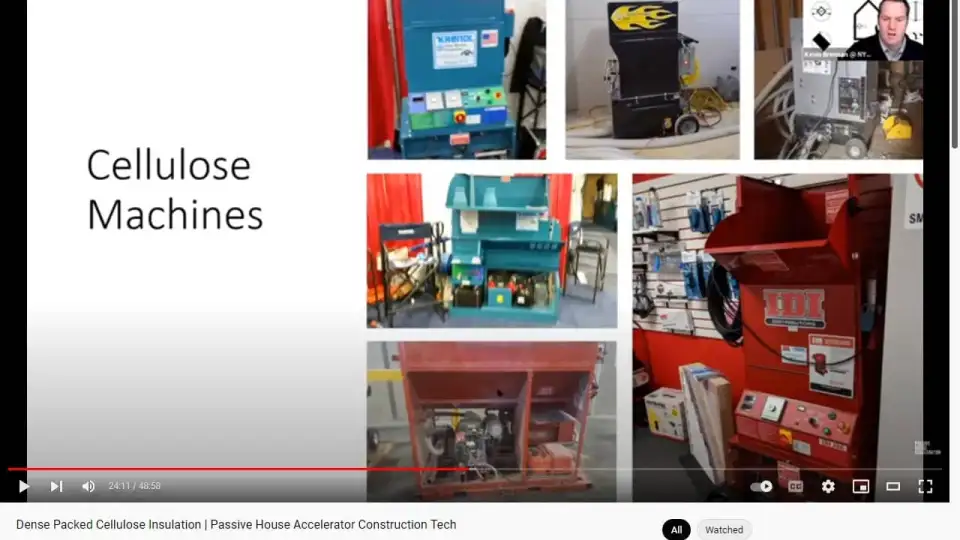
So from right to left, this Krendl, this one is cool machines, this is Intech, another Krendl. This one is a gas powered machine. And then this is the one that especially made for IDI our distributor that kind of it's a contractor friendly machine. Working in the five boroughs access. We bring our machine inside. So we don't pull up on a truck and just blow from the truck because of access and alternate side and things that. So we need a more mobile machine. So either this machine, the cool machine or the other IDI machine would be beneficial for us if we ever get another cellulose machine.
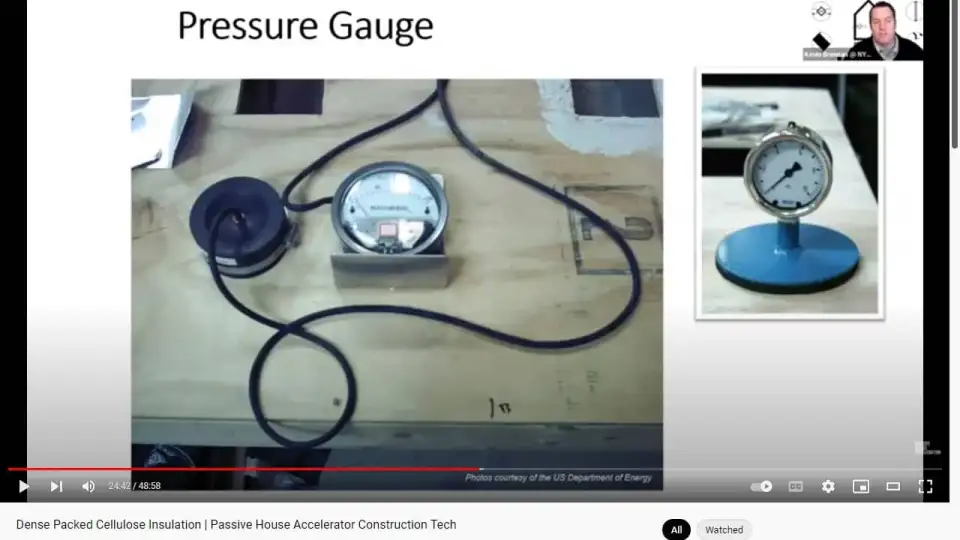
So how do you know if your machine is working well? So all the machines either work on generator power. They definitely work on either two 15 Amp circuits, or maybe even three. My machine that I have works on two 20 Amp circuits. If they don't have the right power, they don't operate right. So the electricity is very important. And then each day when we started the machine we make sure that from the night before the last time we used it that it was clean, there's nothing in the hopper.
You'd be surprised of how things can get thrown in the hopper when you're not around on a construction site every day and even when you are. So we check the inside of the hopper and then we check the pressure. We check the pressure with the pressure gauge on the right, which checks the pressure at the unit. And then the pressure gauge on the left here checks the pressure of the hose and the unit. So say your machine was making three PSI, but you had a bunch of leaky hoses or some bent fittings, you wouldn't be getting three PSI at the tip of the nozzle itself. So kind of the general rule thumb is that you want at least three PSI at the tip where at the machine to ensure that you're dense-packing properly. This is my machine in my trailer. It has an integrated pressure gauge that's on there, lets me know I'm in that sweet spot of the pressure. And here's a quick video of how the machine operates. All right. Cellulose machine is operating.

All right. So as you can tell how the machine operates inside the machine, there's the augers which chew up the material and process from a compact state. And they start to condition the material. Some of the other machines have a shredder, which even kind of finally shred the material before it gets into what we call the chamber, the blowing chamber, where the seals are. The seals go around almost kind of a river boat or so or just a chamber that goes around and then the air pressure gets put across. So what makes the chamber work is the pressure from the blowers.
The blowers themselves give it the oomph. So if the chamber that the air and the material are in isn't sealed tight, it loses pressure it's not going to be a good seal. So one of the maintenance keys is to check your seals and change them regularly. The other maintenance key is to make sure that hose is working with you, not against you. As the material goes through the hose, it's building up friction and it should break down the material before it gets to the tip. The manufacturers recommend at least 100 feet of hose. Some of them recommend 200 feet of hose.
So we're always running anywhere from 100 to 200 feet a hose. And then they recommend that you change your hose every six months. We don't work every day blowing cellulose. So normally ours is around every year or two on our frequency. I keep hours going across.
Tubes. All right. So dense-pack tubes. Sometimes you have winter dense-pack tubes that the plastic is hotter and maybe the plastic is a little softer under colder conditions and it gives the ability to bend and you have summer tubes that are kind of more rigid and under warmer conditions it'll be stronger and not bend as much. The tube thickness is inch and a quarter and inch and a half. My preferred tube is this tiger flex hose here that gives me a decent amount of production that goes through the hose. I am considering getting the two inch tiger flex hose. Every time you increase the diameter of your hose you increase your efficiency or your production quite a bit. So from inch and a quarter to inch and a half and then we've discovered these nozzles, these XFLOC hard insulation needles and they're just a rigid tube that's bent. And it helps us get into those deeper cavities.
There's a few more videos that I'll show you what's going on there. Now this is a longer video. Let's see the dense-pack process behind the wall.
You can see I'm wearing a PAPR and a Tyvek suit there. You get a little tired of getting dusty and blowouts in your face. Just see the blow out soon. You wear the PAPR just to keep the dust out of your face and your eyes. It makes working a little more easy.
So as it goes in fast forward mode, that extra pack the tube blowing air only pushes all the cellulose to the side and separates it through pneumatic pressure and gets it all the way down to the bottom. So you're getting a mechanical pack of that and then getting rheumatic pack on your way up, especially behind plywood. This will follow the machine all the way back. We're up almost three stories on here. They're replacing the stairs, which makes access always a lot of fun. Bring it back almost 150 feet a hose there. And this is our machine set up on site inside working on two different power sources. A little quick image of how the agitator operates.
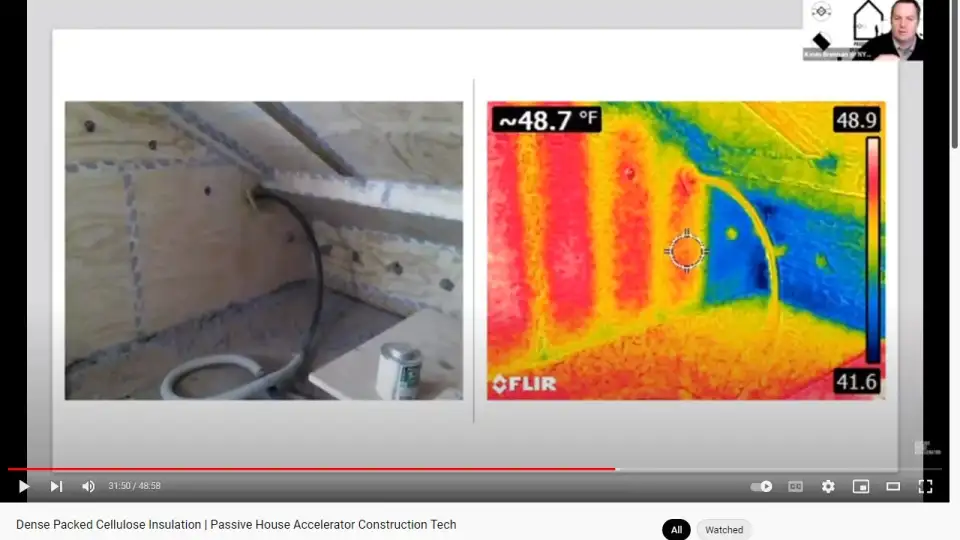
One of the infrared pictures, I'm going to speed up now hopefully you get through all this. I know I'm a little back up upon time, but this is a way that we keep track of which cavities are being next that we don't skip especially when you go to lunch or you take a break. The friction in the machine builds up heat and when you install the insulation in it goes in slightly warmer, and the infrared camera is just a great way to make sure that you didn't miss any bays, or nooks, or crannies, or odd framing members.
One of the lovely hazards of cellulose is static electricity. One of the tricks of the trade is to throw a little graphite inside the machine to make it smoother. But on a low humidity day the static electricity sometimes it gets you no matter what. And it always gets you when you're least expecting it. Ah, wow. That hurt. And always it catches you off guard. One of the benefits of doing cellulose is that in a passive house project it helps you find some of your leakage. There's a hole there. So we've got all the benefits of cellulose.
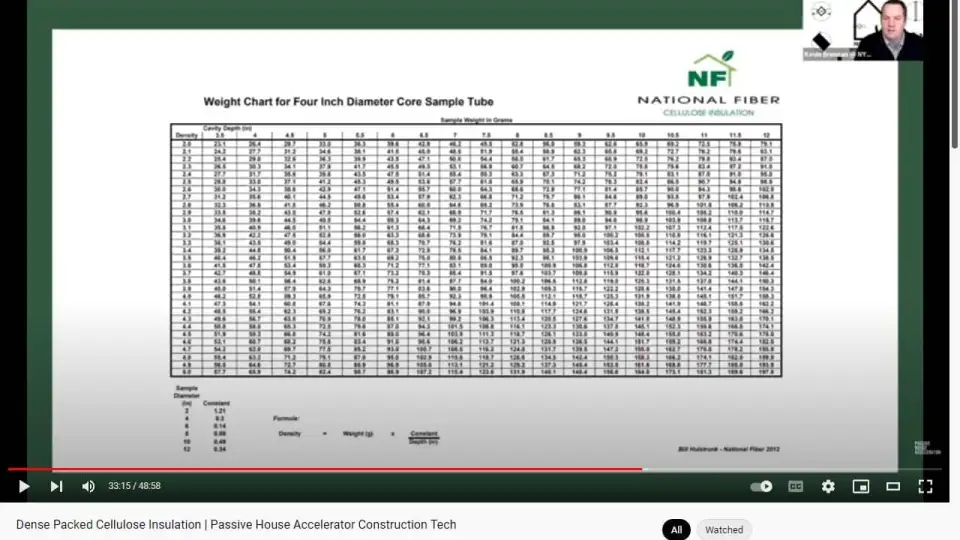
Now, how do you keep track of density? So this chart was put together by somebody that I consider a mentor and a friend in the industry, Bill Hulstruck. He used to work for National Fiber. The man was a Jack of all trades when it came to cellulose, he knew everything from the machines, to the product, to the process, and really supported the guys in the field that were doing the work. I was at the national weatherization kind of regional weatherization competition where it was kind of a rodeo and he helped one of the teams win the competition. He tuned their machine, he checked their pressure and I had a little bit of envy that we didn't participate in it, but they had a really good coach. So Bill was a great coach and then knowing where the world was going and deeper cavities and higher densities, he created this chart and I've been using it ever since and it's been a staple of my practice.

So one of the things that we do on every project is we do core samples. I choose an area that I know is hard to work. I'm either low, high, up on a ladder that maybe I'll take a mark on the wall. And when we know we took lunch and we'll open up that area and we'll check the density. So we open it up, we measure it, we weigh it, then we measure the five inch cavity, 69 grams that comes out a 4.2 pounds per cubic foot. So I'm confident that right here at the hardest level that we have hit our density.
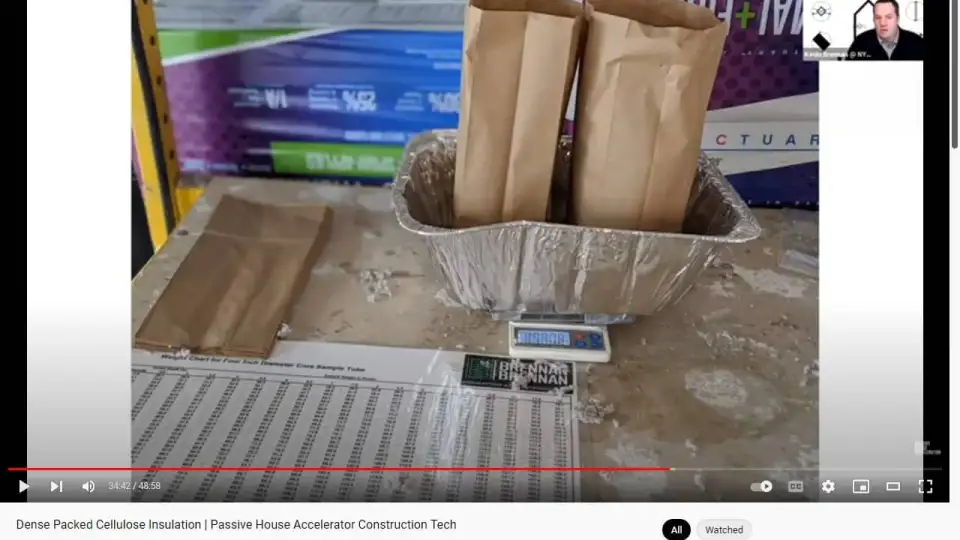
This is our density check station. We use lunch bags. So rather than putting them in and hand stuffing them, we just take paper bags, put them in paper and stuff them back into the cavity and there's no vapor density change whatsoever. We blew up the chart, we added a logo, but I do give Bill credit for creating the chart. But it's a part of our practice and our process. This is mainly here to make sure that nobody throws it out on us really.
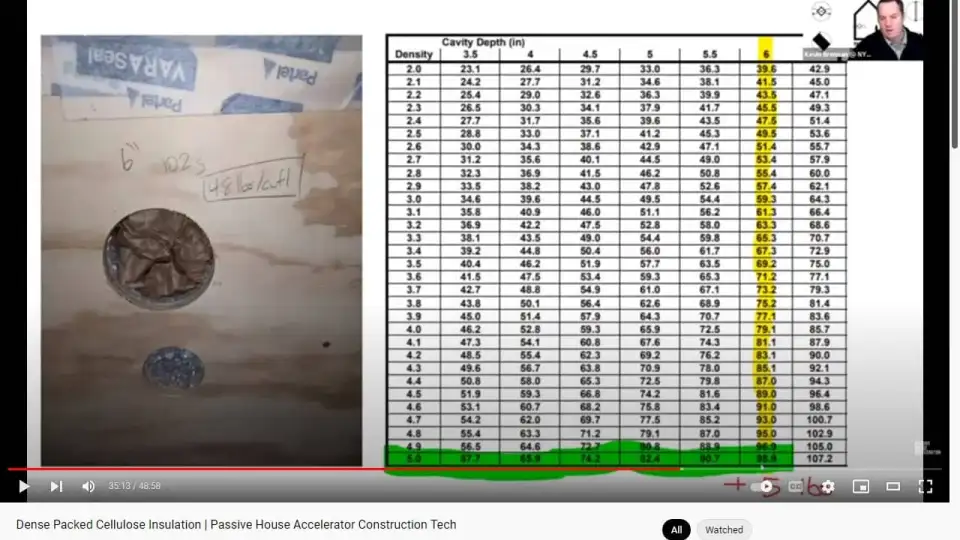
So here's a quick little exercise of the technique and the technology, a passive house is that we have a six inch cavity weighing 102 grams. We would go to the six inch here, follow it all the way down and we'd see what our gram weight is here on the scale. And we'd know that at six inches we're greater than five pounds per cubic foot. So this is just to showing you guys how you would use that chart, not rocket science, but sometimes you just need a little bit of handhold.
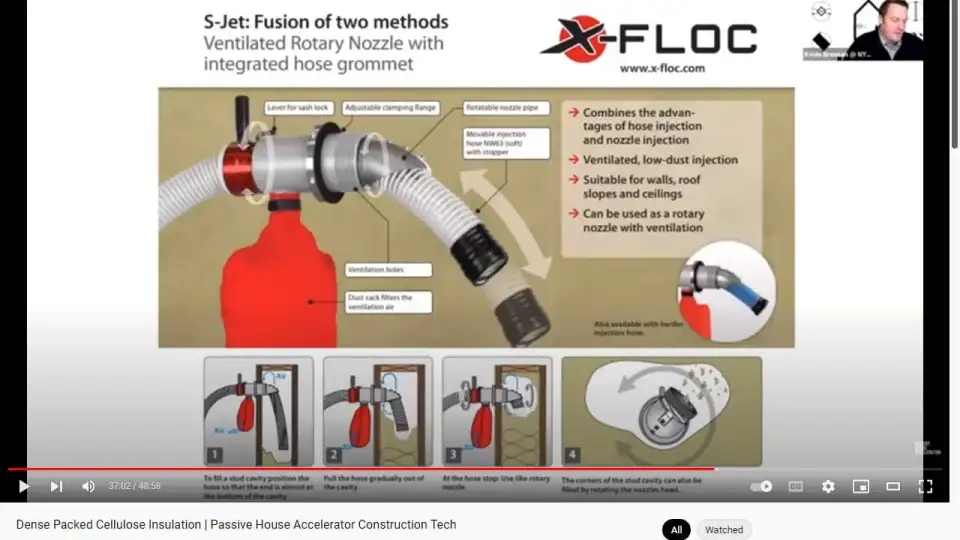
This is the XFLOC nozzle. So in my training I went over to Ireland and met a good friend that hopefully I'm able to get on the show. His name is Roman. And he's a German guy working in Ireland doing dense-pack cellulose and passive housework. And we just instantly at the training had a bond. Oh, what kind of machine do you use? Oh, what's this? And we shared knowledge and back and forth just by traveling outside of our borders realizing that there's other cellulose machines and manufacturers out there. Discovering that the XFLOC brand is out there innovating and really kicking the cellulose world to the next level of those thicker wall assemblies and everything.
So this is the S-Jet. The S-Jet is kind of the tube fill method with the rotary nozzle on it. The tube goes in and down just like we would take the dense-pack nozzle, but it's doing it at a larger size hose. And then as you come up to the top you do the ventilated size. It's dust free. It's a nice, we have it and we use it quite regularly. But it's a great innovation and project.
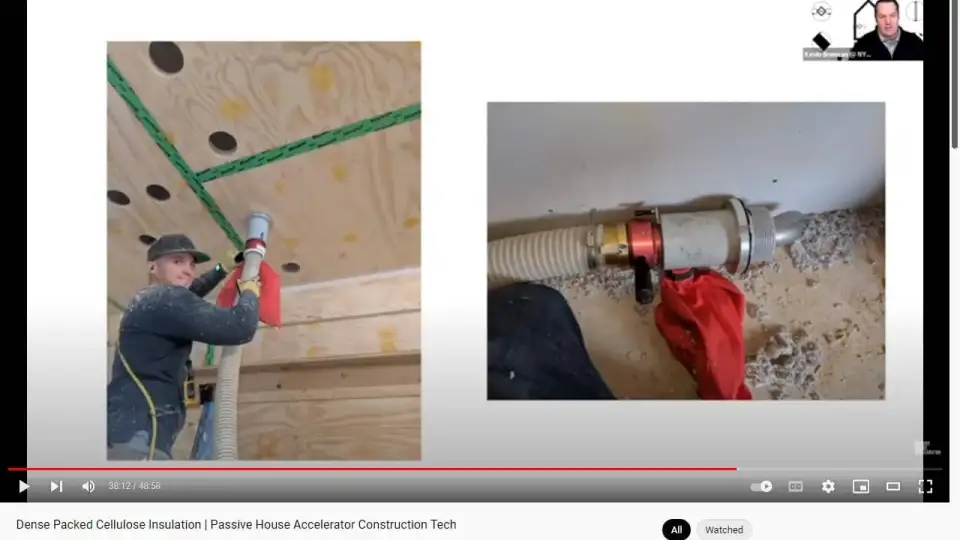
So if this is the ventilator rotary nozzle in practice, to be honest with you, it works a little better in solid cavities. So if you have two by 10s or two by 12s and you're blowing small little cavities, like Mike is here, it's really good at doing that. Whereas we're a little bit more used to getting the flexible tube and getting a little more tactical fill inside the cavities with the smaller dense-pack tubes when we have open cavities say trusses or double stud or furred off the wall stud. These are solid plywood box golf kind of cathedral ceilings. Each one is about two or three feet. So it's fully filled. You're done. We'll just take a little, a handful and plug that hole. This is the XFLOC insulation needle. You can see how it's got a curve to it and Timmy is going to poke it in the wall to show how you get a fat cavity filled with insulation.
He takes the tube and he's angling it. That's why the tube has an angle. And then he's got it all the way down to the bottom. Now go to the side. Beautiful. This is the XFLOC insulation. And this one he's just doing a different cavity. It's going up, just shows that the tube is going up into the right at the top. He can feel it, you can touch it, you know where it is and it's just a pretty good way of doing a larger cavity quicker and faster. Because cellulose is all about production. I'm doing two and a half inch opening and getting that hard nozzle into the spot.

It helps me to be more productive than working with the inch and a quarter nozzle. That would be. So one of the other tricks to the trade of doing cellulose to these density boxes these are two by four density boxes. This is more for home performance or residential work, whereas you'll be setting your machine up to know what your settings are, your air pressure and your gate to do 2x4 walls. And how it works is that this 2x4 is two cubic feet of volume on the inside, three and a half inches. And when you blow a dense-pack three and a half pounds per cubic foot, it should increase by seven pounds.
So you should take that density box, weigh it with a fish scale or a bathroom scale and then you would know that it's at the right density. It helps you set your machine up. One of the things we'll be doing in the future is creating density box checks that represent our walls either with Intello or say plywood. And then the trick of the trade is once you blow that density box is that you think you did a good job before you weigh it. You take off the cover and you hold it above your head. And if you didn't do such a good job, you get say a little shower. And then if you did a great job you did it. That's the kind of trade rite of passage I guess you could say.
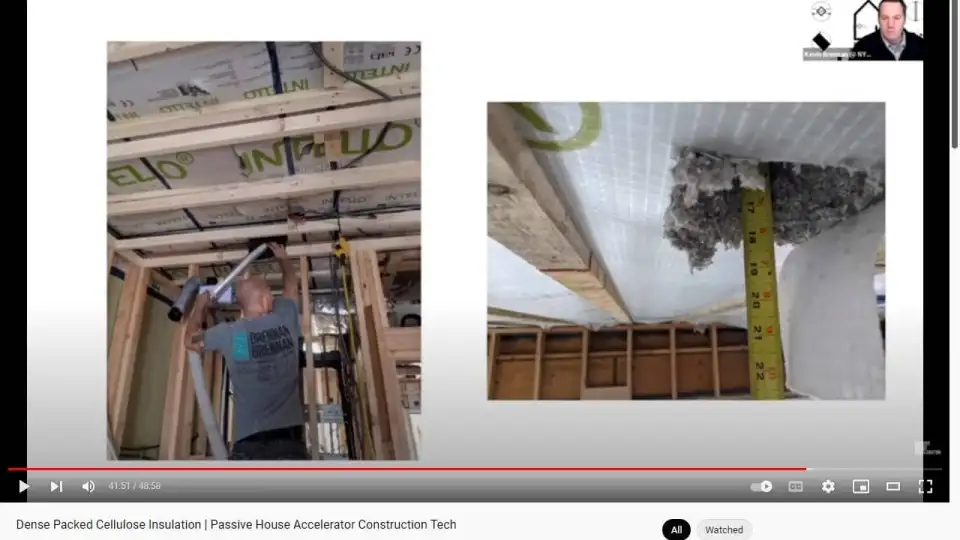
In our projects we also do not only walls, but roofs. This is a 17 inch cavity. When we do the 17 inch cavities most of them, that's an eye joist, that one, we really have to spend a decent amount of time making sure that you get the nozzle in the right spot and doing those density checks. That's where those insulation needles really come in handy.
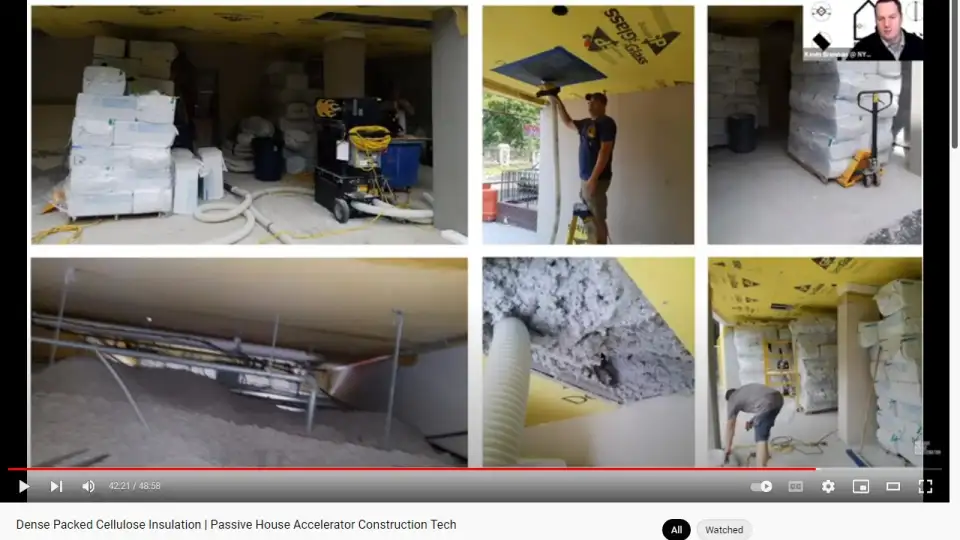
We've done other cavities that are up to 24 inches. This is a garage ceiling in a passive house project in Harlem Multifamily project. We did 24 inches of dense-pack cellulose in this area. We got almost an entire track to trailer filled with cellulose and the logistics of it. Luckily it was in an overpass and a garage because we were able to store the cellulose in the garage area and it was fun. And we used some of the membrane to keep the dust down and help us from picking up, from having to clean up.
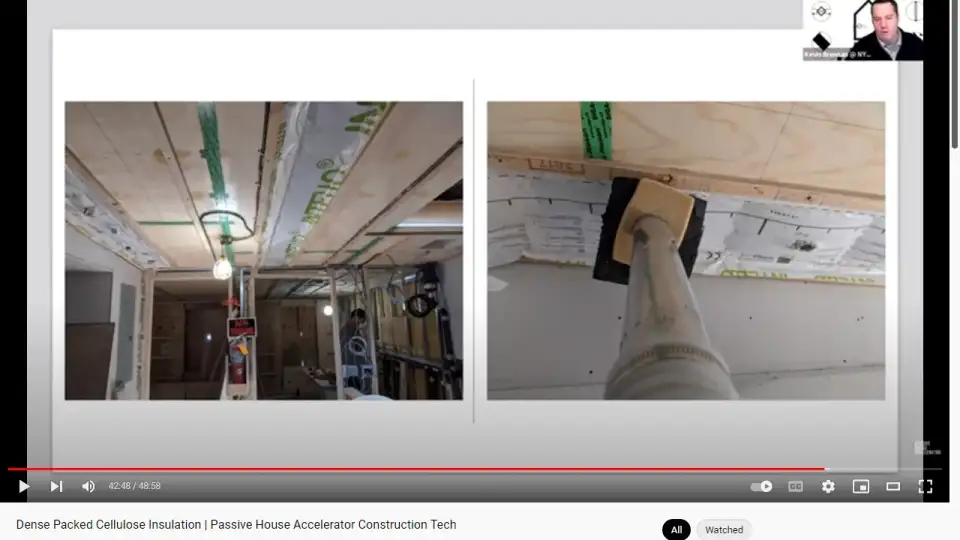
One of our other tricks is to put up membrane as opposed to drilling holes in the plywood. That gets tedious and laborsome, we throw up a membrane or a netting and then we'll blow through that, and then we'll peel that down and put back up the plywood that goes in there and tape the seams. So this is a trench method is what we call it. Whereas we go left, we'll go right. And we can do almost an entire ceiling with two trenches and a few holes rather than having to drill a hole every single one and then patch. So one of those things.
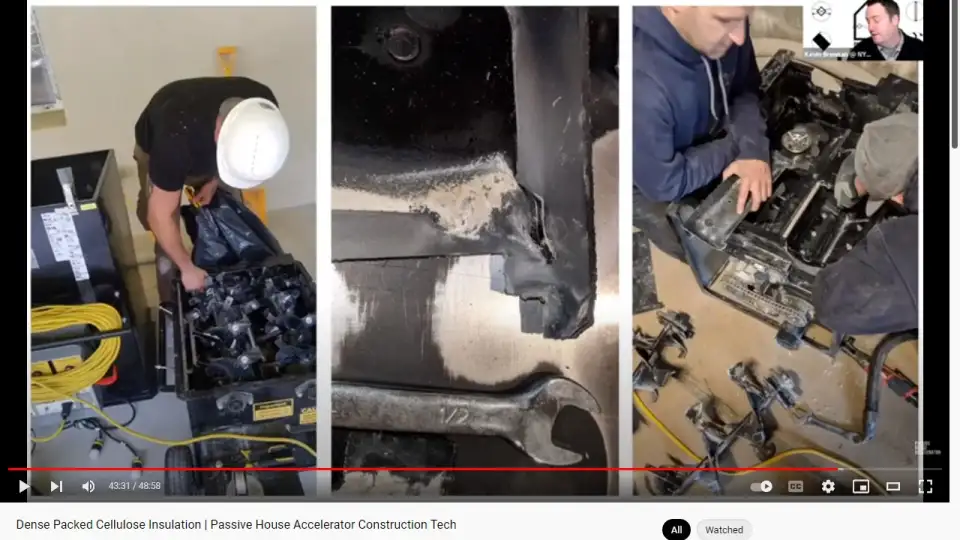
The key to getting cellulose machines to work is regular maintenance. Just like in the airplane, how many hours has the machine been running and then put your lube in and the gear oil in the right spots and change your seals. The one in the middle is a split seal. When you run your cellulose machine and you see volcanoings and things that are popping out means that you have air leaks and you should change your seals regularly. Thing I like about the cool machine is that it's rather easy to work on. We're able to take out these augers, disconnect the chain, rather easy, change the seals without having to do acrobatics and getting under a 200 pound machine and it's nice to work on.
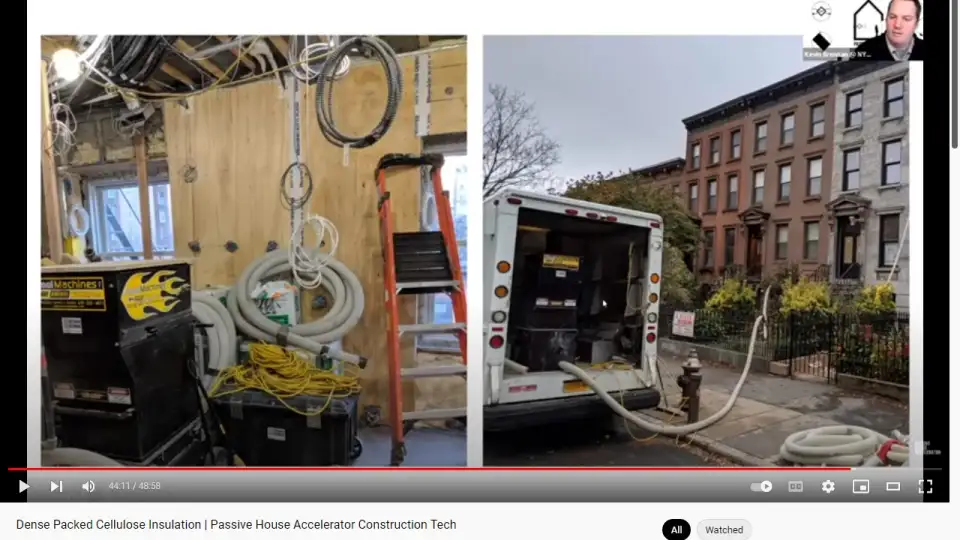
This is our setup, our hoses, they get changed regularly going across. This is our machine inside. We have a cover making sure that the team that we're working with isn't throwing, putting a screwdriver on and it winds up in our machine. That don't ask me to know how that happens. This is our setup when we had the luxury of being able to park for a few hours in front of the fire hydrant and listening very closely to make sure that you're not blocking for a fire, but this is our setup there.
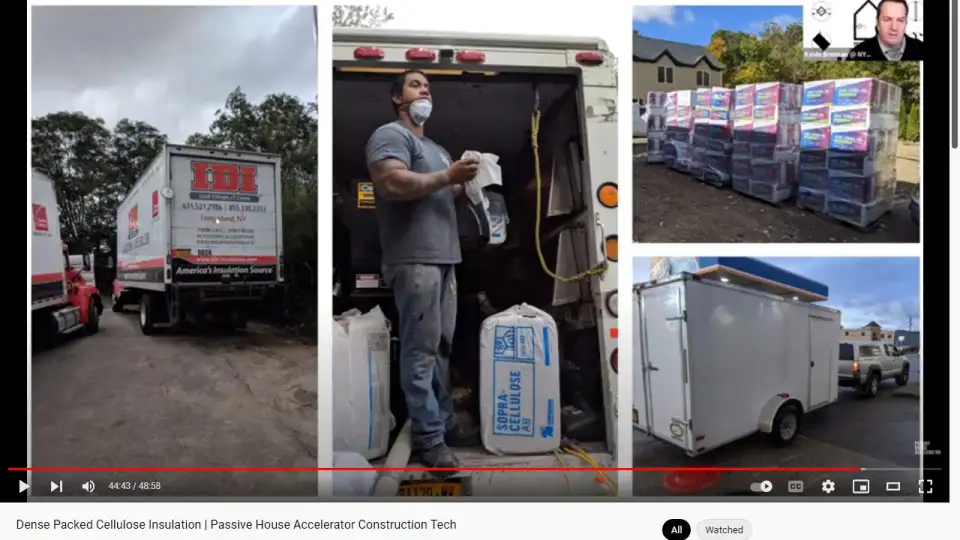
Logistics. So having a good partner that could deliver for you is important, delivering pallets quick, fast, efficient, and then having a good crew of guys ready to offload and get it in the building without too much distress and despair. So we use IDI here in New York from Long island. We have purchased half trailers and full trailers worth of cellulose. It just tends to be a little troublesome on the logistics and the warehousing and renting a forklift to load the trailer or the truck itself.
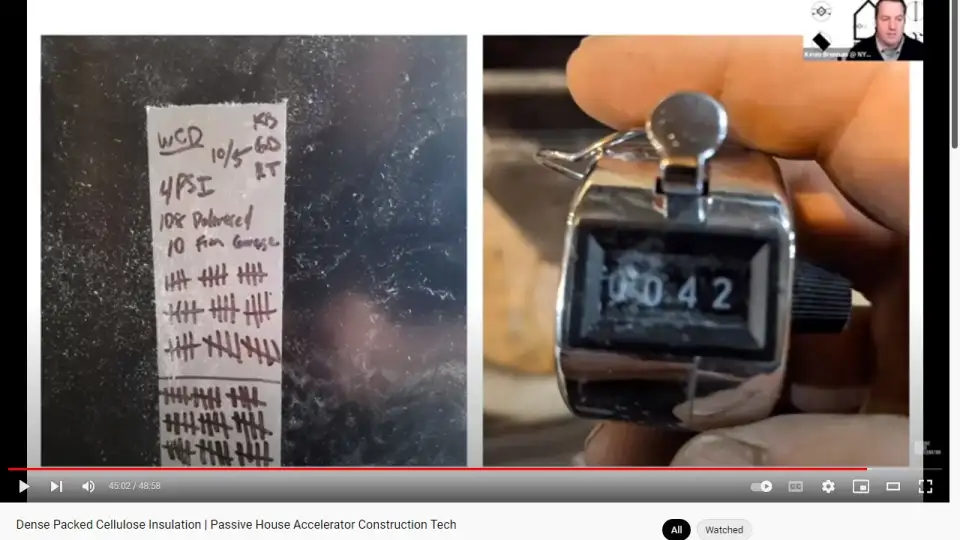
The other way to keep track of how much progress you have is keeping track of how many square footage you've covered and how many bags you've done. The hashtags hash marks on the side here is our daily product. This is our daily pressure test for PSI. We got 108 delivered. We had 10 from the garage. This is who was working. And it's kind of a challenge to see if we can beat the other day's production.
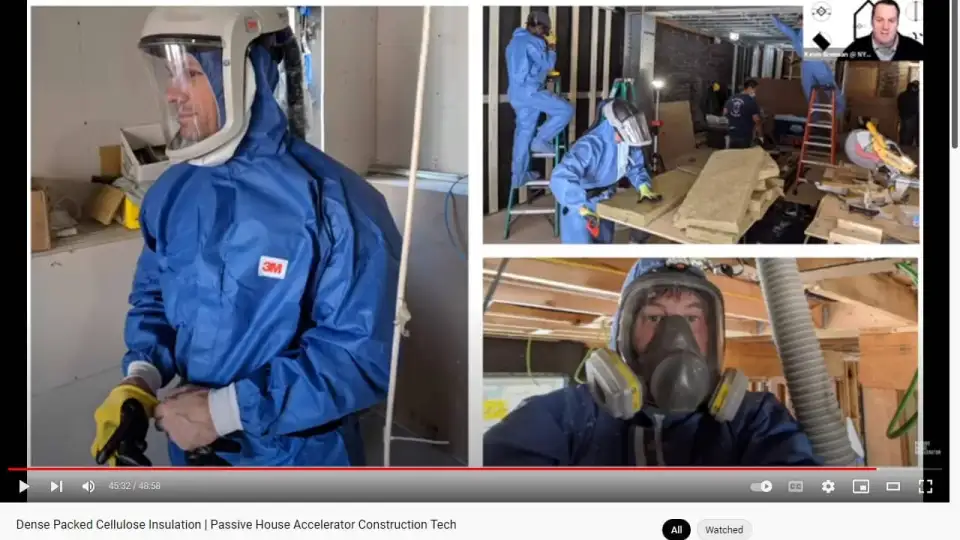
Safety. So borate is not technically on the list of a respiratory hazard, but it is kind of a Newson in that if you blow it every day it can dry out some of your skin and make it irritated or so. So over the past few years as the owner of the company I've just kind of implemented good safety protocols, which means Tyvek suits to keep the dust off your clothes so you go home and you're not covered in it. And then the respirators making sure you're either using a full face piece respirator to protect your eyes or the PAPR just to make it a little easy to work on. And that goes for not only blowing cellulose, but also installing Rockwool. Everyone has got their Tyvek suits on, they got their gloves, their respirators are on. You're working above your head, you're looking up, it's very easy to get things in your eyes and you get something in your eye you're shut down for five minutes. It's a production hazard more than anything else. Other parts of safety are this negative air machine creating dust.
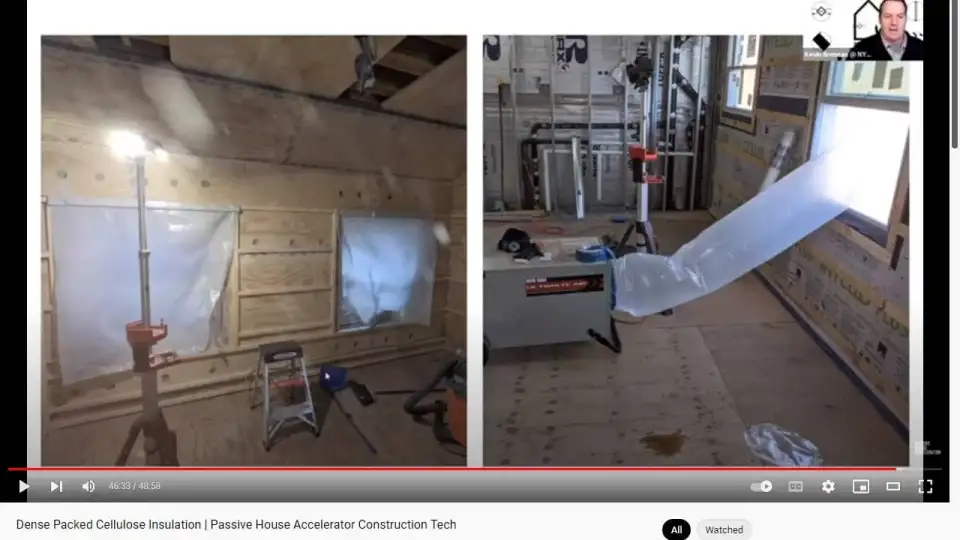
You want to control the dust and bring in fresh air to keep that across. So this is a hepafilter, collect the dust, just take a negative pressure, keep the dust us from being in one zone to the other and lighting. To me on construction sites lighting is the biggest hazard. Because even though it's under construction, they put up temporary lighting. It's never perfect where you need it. So we always have temporary lighting. And the last part is communication, right?
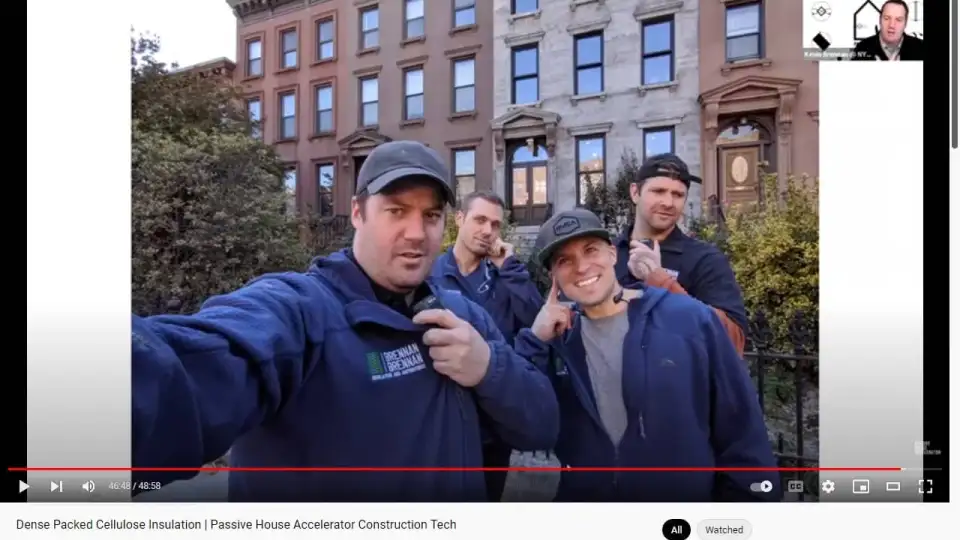
A funny picture, the guys that are able to work with me, but we have these walkie talkies and we talk like we're at the firehouse. Nozzle to control. You got 15 bags left. All right. I think I have a clog. I think I have a clog, he checks the machine, we shut it down.
We purge the machine. It prevents us from having a breakdown the hose and chase leaks. And communication is important especially when you're working with a limited man crew. Somebody falls off a ladder, twist their leg, you want to stop right away, be able to help them. So we work with radios and voice mics and things like that. It's important.
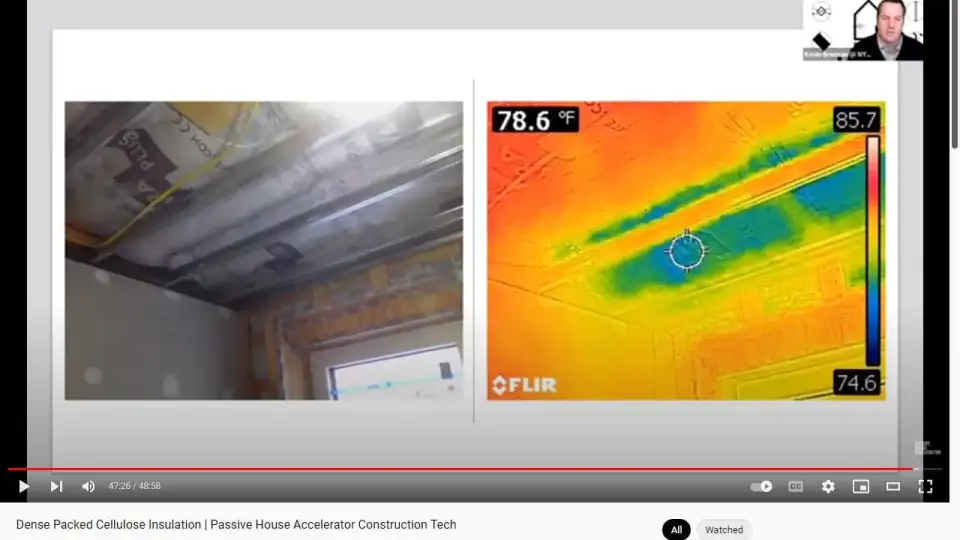
And then the last part of the presentation is kind of the lessons learned of quality assurance. While walking around with the thermal imaging camera checking for and we missed any bays or cavities or so we noticed the this cold spot in our insulation in the ceiling. And we were like, what's going on there? And what we didn't realize was that the permanent roof wasn't on.

So the roof wasn't on, wasn't the permanent roof. It was just a temporary roof on the top. And they developed a water leak and the water leak was showing through the cellulose. So then we had to take out all the cellulose that was up there and we needed to do it. But the thermal imaging camera kind of helped us find it.
And then it wasn't such a big deal because the drywall wasn't up, it was just a few bags, a patch, a pole, and a replacement just took out everything that was wet. Once they put the final roof on then we went back and we redid the work. So kind of the lesson there is to don't blow cellulose in a brownstone roof, unless it has the permanent roof on or the temporary roof that's the underlayment or something that's a little more durable than what's currently up there.
So I just want to thank for that presentation. I think I've used all the time I possibly had.
Boom.
